#medieval illumination inspired
Text




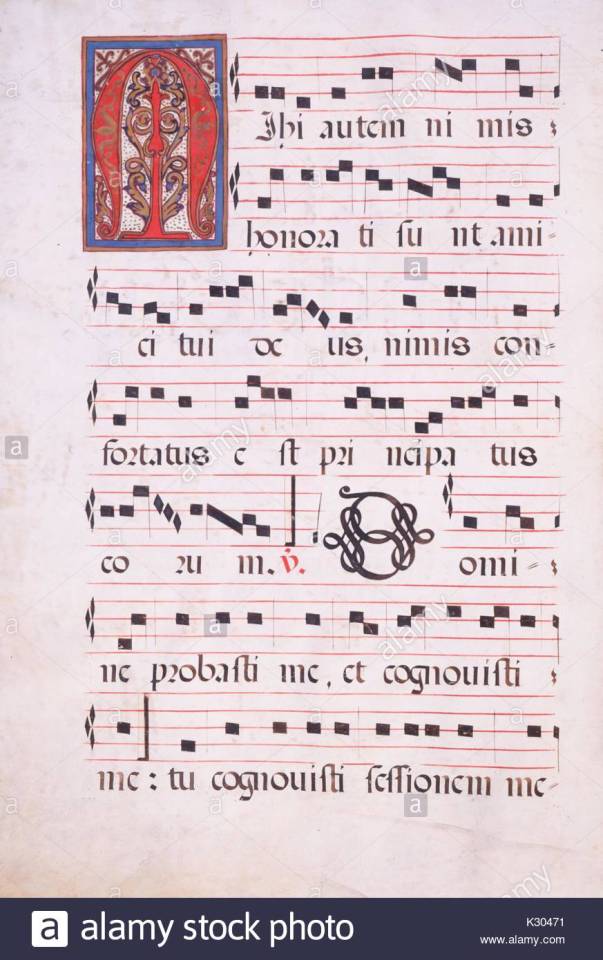





#collage inspiration#collage material#medieval manuscript#archaic illustration#illuminated manuscript#medieval illustration#medieval music
4 notes
·
View notes
Text


finished this project ive been working on- a lyric booklet for the black parade inspired by illuminated medieval manuscripts! i think a lot about how the album was inspired by medieval cycle plays and always thought it would be fun to do something with that aesthetic. you can read it here!
#was inspired by mcrzines zine prompt but im not sure if it classifies as a zine?#tbp manuscript#my chemical romance#the black parade#mcr#mcr fanart#mcr the black parade#i feel like this is a weird and niche crossover so im not sure if it appeals to anyone but me haha#but i had fun!#im also gonna post some of the pages here on their own!#mine
2K notes
·
View notes
Text

"I wish the IkePri guys wore actual medieval clothing 😔"
my monkey paw: curls
inspiration below the cut ↓
ref for the illuminated manuscript (BG)
ref for their clothes
#''is clavis wearing a c-'' a codpiece? why yes of course. gotta protect the royal jewels.#one thing about me is that i will always put maximum effort into a joke#ikemen prince#ikepri#chevalier michel#clavis lelouch
97 notes
·
View notes
Text
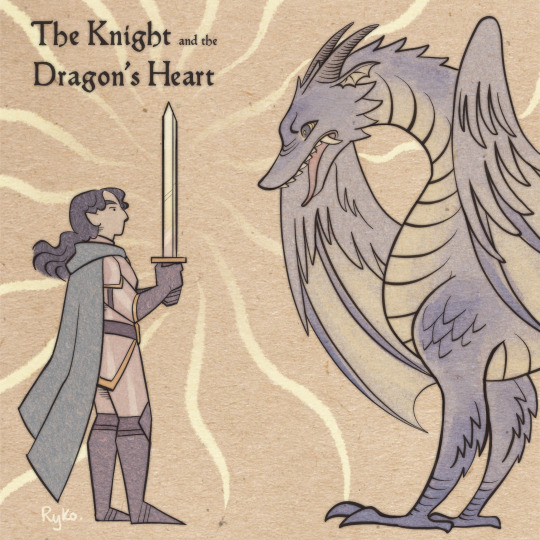
TAZ SAPPHIC WEEK DAY 1: Dragon + Sword
Teaser for tomorrow: Cowboys!
+extra sketch. Check under the cut to see my idea notes for what I imagined the story of this AU would be ;-)
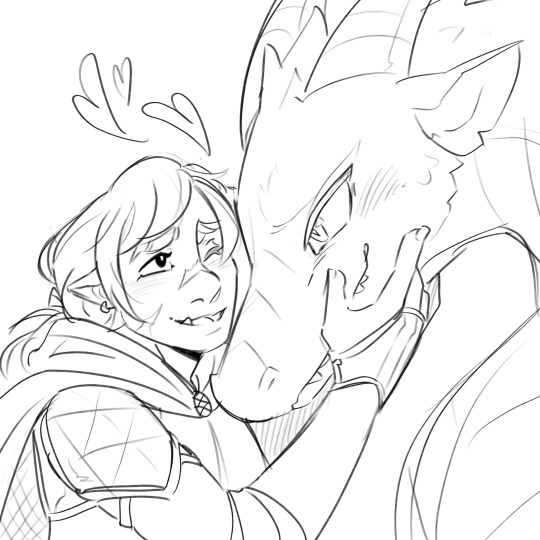
Idea: Killian is tasked with rescuing princess Carey from the clutches of a dragon. But when she gets to the castle, she realizes that princess Carey IS the dragon, and that she is happier in this form. In the end they run away together!
Tried something different with the main piece because I wanted it to feel like a ‘cover’ of the story. Inspired by medieval style tapestries and illuminated manuscripts, but slightly stylized.
#taz sapphic week#taz#the adventure zone#taz balance#tazb#carey fangbattle#taz killian#team sweet flips#the dragons in medieval art are so. varied and a little fucked up lol#i referenced a couple but ended up stylizing it#for Killian I also wanted to follow the style of illuminated manuscripts and make it super detail and funky#but then I decided to lowkey reference the tapestry arts that you can see in po/kemon s/wsh. like in hammer/locke vault.#cuz theyre pretty simplistic but evocative.#sometimes ya gotta trim down your ideas cuz you simply won’t have the time to fully execute everything
214 notes
·
View notes
Text
Merlin Binding
I wanted to make a gift for my absolute fandom bestie, so I put together an anthology of three of forcryinoutloud's Merlin fics: Idiosyncratic Romance, The Hands of Fate, and King Once and King to Be. (note: they are locked on A03).
I knew as soon as I thought about it I wanted a medieval inspired, illuminated manuscript type design. The cover is faux suede with gold foil, and the dragon is Arthur's coat of arms.



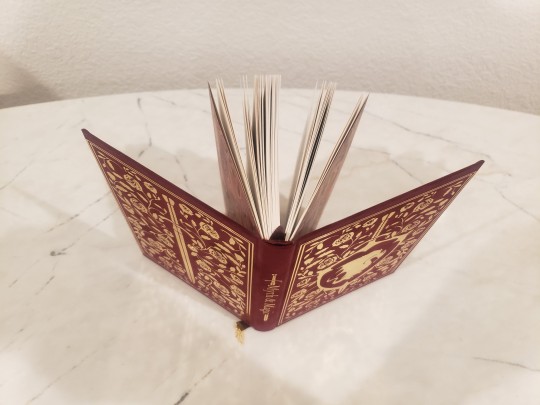
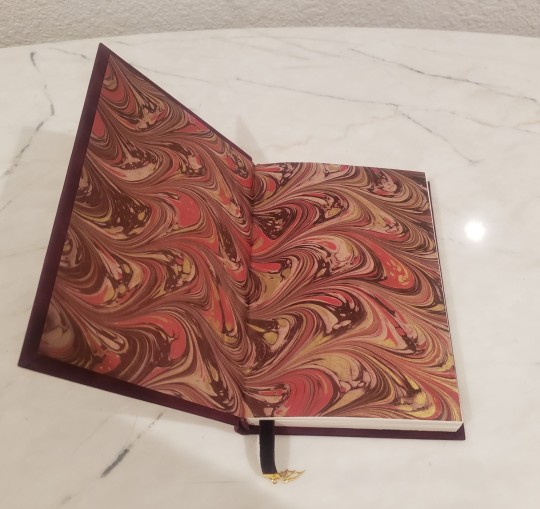
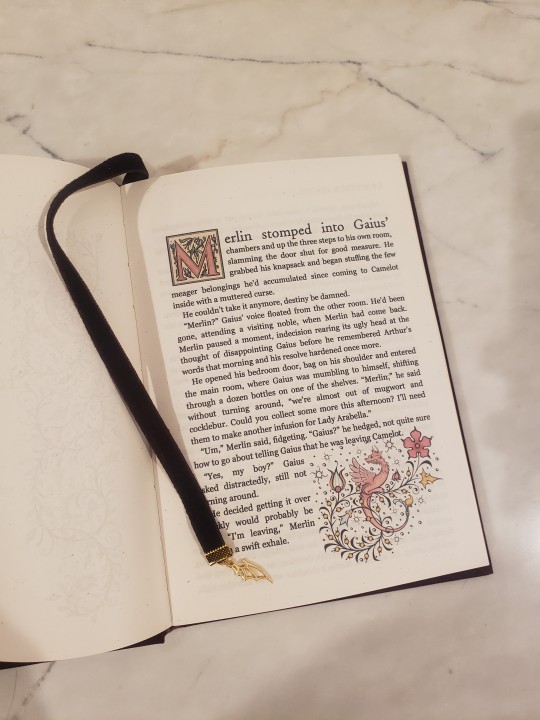

565 notes
·
View notes
Text
Btw, for anyone who is into medieval history, I HIGHLY recommend this book:

"The word “medieval” conjures images of the “Dark Ages”—centuries of ignorance, superstition, stasis, savagery, and poor hygiene. But the myth of darkness obscures the truth; this was a remarkable period in human history. The Bright Ages recasts the European Middle Ages for what it was, capturing this 1,000-year era in all its complexity and fundamental humanity, bringing to light both its beauty and its horrors.
The Bright Ages takes us through ten centuries and crisscrosses Europe and the Mediterranean, Asia and Africa, revisiting familiar people and events with new light cast upon them. We look with fresh eyes on the Fall of Rome, Charlemagne, the Vikings, the Crusades, and the Black Death, but also to the multi-religious experience of Iberia, the rise of Byzantium, and the genius of Hildegard and the power of queens. We begin under a blanket of golden stars constructed by an empress with Germanic, Roman, Spanish, Byzantine, and Christian bloodlines and end nearly 1,000 years later with the poet Dante—inspired by that same twinkling celestial canopy—writing an epic saga of heaven and hell that endures as a masterpiece of literature today.
The Bright Ages reminds us just how permeable our manmade borders have always been and of what possible worlds the past has always made available to us. The Middle Ages may have been a world “lit only by fire” but it was one whose torches illuminated the magnificent rose windows of cathedrals, even as they stoked the pyres of accused heretics. "
----------------------------
It is an absolutely wonderful, humanistic depiction of the middle ages, spurred on by a wish to reframe our view of it as the 'dark ages'. I am about halfway through it and it has made me cry plenty because god, PEOPLE.
I first heard about it on the Medieval Podcast when Daniele Cybulskie interviewed the authors:
And have been slowly chipping away at it with my other books I'm reading.
#text#books#i love love love the medieval podcast and also this book#and i HIGHLY HIGHLY HIGHLY recommend both!#Spotify
156 notes
·
View notes
Text
youtube
My sister FINALLY published her short film called Hunting Rabbits, inspired by medieval marginalia/manuscript illuminations! Go watch it!!
#medieval#medievalisms#manuscripts#animation#jam posts#im gonna be reblogging this a few times bc I really want people to see it#Youtube
774 notes
·
View notes
Text


Designs for my graduation cap. I'm graduating from a master's program in May and my thesis was on Eurasian Lynx reintroduction. I included 2 variations: one with a radio collar, and one without!
The designs were definitely inspired by heraldic designs and medieval illuminations.
21 notes
·
View notes
Text
Mermaids and Mr Freud...
What do you think when you hear the word “mermaid”? Chances are, you’ll imagine a beautiful girl with a sparkling fish tail, naked breasts, flowing hair, gazing into a mirror: a scene straight out of early 20th-century Golden Age illustrators Arthur Rackham and Edmund Dulac. Or perhaps you see Ariel, Disney’s 1989 cartoon version of Hans Christian Andersen’s The Little Mermaid, with her cherry-red hair and purple shell bikini. That romanticized – and Disneyfied – picture of a mermaid seems fated to endure with this year’s live-action The Little Mermaid film (though the casting of Halle Bailey in the title role has prompted as much racist backlash as it has celebration. The mermaid of Andersen’s 1837 fairytale was white, say the purists.)
But Andersen himself drew on a far older, stranger, and more subversive folklore to write his story. His tale of a mermaid who, falling in love with a human prince, is forced to sacrifice her tail and her voice in order to become human, was deeply influenced by Undine, the 1811 novella by Friedrich de la Motte Fouqué, which in turn was inspired by the 16th-century occultist Paracelsus, who coined the word “undine” to describe an elemental water spirit who can only gain a soul by marrying a human. And mermaid legends, like so many other fairytales, have been shared in many parts of the world for millennia.
One of the earliest mermaid stories dates back to sometime around 1000 BC. In Assyrian mythology, the goddess Atargatis, who was venerated for thousands of years all over the Middle East, attains a half-fish, half-human form after throwing herself into a lake. The Yoruba spirit, Yemoja, who is represented as a mermaid, appears under other names as an ocean and river mother goddess – Yemaja, Yemanjá, Yemoyá, Yemayá – across half the world. Mami Wata – a water deity sometimes known as La Sirène - revered in Haiti and many parts of Africa, often appears as a mermaid, with a mirror that allows the passage from one plane of reality to another. And so it goes, from the ningyo of Japanese folklore to the sjókonar of Norse sagas. It is one of the most powerful archetypes in our shared dreaming.
Nor were mermaids always understood to be mythological. Throughout the Middle Ages and beyond, European bestiaries and illuminated manuscripts portrayed mermaids as real creatures. On several occasions fishermen have claimed to have caught them in their nets. Early explorers reported mermaid sightings – although it is more likely that they were dolphins, seals or manatees, mistaken for mermaids by sailors expecting to encounter exotic beasts on their journey. Since then, humans have stubbornly continued to look for proof that mermaids are real (so far, without success).
What does the mermaid mean? Why is the half-fish half-woman such a potent, enduring legend? At the heart of these stories is the question of women’s power. Fairy tales and folklore have played an important role in challenging societal roles and giving people opportunities to discuss difficult or taboo subjects through the safety of metaphor – in this case, through the image of a woman whose irresistible sexual power over men is balanced by her own inability to function sexually or to reproduce. And in the days when pregnancy and childbirth often proved fatal, that might not have been such a bad thing. The mermaid cannot be raped, or forced to give birth. Not being human, she is not bound by the conventions of human society or the laws of the Church. She enjoys both the freedom and the sensuality of her element without any of the attendant dangers or discomforts.
In folklore, the mermaid has independence, and can exercise sexual power over men, which makes her ultimately dangerous, unnatural: a monster. Perhaps this is why so many ancient myths and medieval bestiaries depict mermaids as untrustworthy, deceitful creatures, leading sailors to their doom. Their bodies are all sexual promise, but no sexual reward; and their voices are so enchanting as to drive men to madness. Unable to fulfil what some believe to be a woman’s biological destiny, they are often portrayed as soulless. Because a woman who uses without being used, who seduces without being seduced, who moves through water and air – whereas men are doomed to drown if they venture into the mermaid’s world – is a challenge to God, to the patriarchy, and to order itself.
In The Little Mermaid, Andersen tamed this older, more radical tradition. The moralism of his tale serves the dual purpose of mastering the mermaid – of making her fall victim to a human’s charms, rather than the more traditional way around – and taking away her power. The mermaid, made helpless by love of her prince, gives up her native element and the autonomy that comes with it, and exchanges it – via a witch’s spell – for a pair of feet, though walking causes her terrible pain. She also relinquishes the power of speech, which means that she is incapable of expressing her love in any way but the physical. And if her prince falls in love with someone else, then the mermaid is doomed to die on the instant, and to forfeit the soul for which she has sacrificed everything. Her entire being – her very existence – becomes dependent on the love and approval of her prince. Her independence, her challenge to the patriarchal status quo is gone. Though the ending of Andersen’s tale is – to a certain degree – redemptive (the mermaid, refusing to take the life of her prince in order to save her own life, is borne aloft by spirits of air and promised an eternal soul), it seems very cruel, especially as the heroine is only fifteen years old. A contemporary reader might well see in Andersen’s telling a warning to an emerging women’s movement – women’s power has often been seen as fragile, unnatural, and at the mercy of emotion.
Unlike the tragedy of Andersen’s mermaid and prince (and of Fouqué’s Undine), the 1989 Disney film rewards Ariel and Eric with a happily-ever-after ending. And it tells their story in a cheery, colourful palette (a stark contrast to Kay Nielsen’s original dark, eerie concept drawings for the film), which while being pleasingly child-friendly, also reduces the mermaid’s essential alienness, and minimizes her sacrifice, thereby making her tale into little more than a love story with a little added jeopardy.
But Disney also perpetuated other tropes. It is meaningful that the sea witch who provides the mermaid with the spell fits the older-woman archetype well represented in fairy tales: embittered by age, envious of the little mermaid’s youth and beauty. She is the one who demands the mermaid’s voice as payment for her services: a potent image of an older generation, silencing the voices of youth. (In Andersen’s telling, she too is the one who demands that the mermaid’s sisters cut off their hair in order to save their sibling.) The older woman is filled with rage and contempt for the younger woman; taking pleasure in their humiliation and the loss of their power. And as the tentacled Ursula in the Disney version, she is especially monstrous.
Over the centuries, fairy stories have always been reinvented to serve the needs of the changing times. And people have often fretted about this. (In 1853, Charles Dickens criticised the trend for rewriting fairytales to fit didactic, contemporary concerns.) But perhaps that the meaning of the mermaid has drifted further and further away from its origins in ancient folklore should not be cause for too much concern. Today, the mermaid has become the symbol of the trans community, whose members often feel the generational divide especially keenly. And there are endlessly imaginative ways to retell the tradition. (In 2008’s Ponyo, Hayao Miyazaki spins his tale of a goldfish who longs to be human into a charming meditation on childhood.)
Like the ever-evolving traditions of fairytales, magic, too, is transformative. In stories, magic acts as a metaphor for the change we seek to effect in our lives, in ourselves, in the world around us. Perhaps that is why fairy tales resonate so deeply with us. Why else would we cling to them, retell them in so many ways? They teach us not that magic exists, but that change is possible. They teach us not that dragons exist, but that monsters can be overcome. And they teach us to hope, in the face of a world that seems to be getting harsher and more confusing by the day, that sometimes love can save us, and that, even in the face of the cruellest kind of tyranny, we can still keep control of our fate, and hope for a happy ending –not just a Disney wedding, but something perhaps more satisfying. In films like Moana - or more recently Ruby Gillman, Teenage Kraken – the love story is with the sea; a story of claiming, rather than giving up power. Mermaids – in all their aspects – are still working their magic on us. And now, perhaps more than ever, it’s time to listen to their song.
79 notes
·
View notes
Text
Unconventional Detective Games

Return of the Obra Dinn, 2018
The maritime mystery game Return of the Obra Dinn by Lucas Pope is almost entirely subversive for a detective game. Everything in the game from its core premise to hyper stylized presentation, is all ambitious and experimental. Every person aboard the Obra Dinn has mysteriously died and you assume the role of an insurance investigator piecing together the horrific events using a magic watch that delivers to you a front seat viewing of a vignette of each person’s demise. Using these dioramas of death, you are charged with recording the manner of death of each and each crewmember and passenger aboard the ship.
Return of the Obra Dinn and its addictively satisfying detective puzzle gameplay left me hungry for more. Playing the game instilled in me a deep love for a good mystery and a desire to solve them. While I love games like Disco Elysium, which stars detectives as its protagonists, the investigation was never really the point. Moreover, a love for the unconventional detective was entrenched in my heart and as an interactive medium, video games are perfect for aspiring would-be detectives.
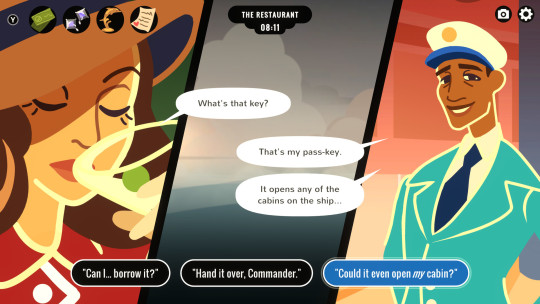
Overboard! , 2021
The year is 1935, aboard the S.S. Hook, Veronica Villensy throws her husband overboard under the foggy shade of night. In Inkle’s devilishly clever puzzle/visual novel, Overboard! you have eight hours before reaching the ports of New York and in that limited time you must relieve yourself from suspicion and guilt for your husband’s death at any cost. It’s a sort of anti-detective puzzle about getting away with murder which forces you to learn your fellow passenger’s schedules, plant evidence, and be consistently careful with your language lest your words betray you much later.
The DNA of time loop games such as Majora’s Mask and The Sexy Brutale is woven into the gameplay loop of Overboard! It’s a fairly short game taking around 2-3 hours to finish the story but at the benefit of allowing an immense amount of player agency. There is a wide variety of solutions to evading the mighty hand of justice, you are free to travel around the ship on a whim with no direction from the game itself. The only hint system is visiting the chapel and praying to God which is both cleverly diegetic and hilarious.
The nonlinearity of your objective incentivizes logical thinking and experimentation. The puzzle is rewarding much like learning each map and NPC routines in the Hitman: World of Assassination trilogy is. At first you clumsily trip over your words when Major Singh interrogates you but eventually you can get away with murder in style along with netting some pocket money from the life insurance if you pull it all off just right!
The nonlinearity of each puzzle in Overboard! is incredibly refreshing, it just feels organic and natural. Going achievement hunting in this game is its own little puzzle and I still haven’t figured out some of the little secrets it hides from us. It’s a game I can’t put down and haven’t yet been able to stop thinking about and I really recommend giving it a shot since it’s only $15 and only $6 if you catch it on sale.

Pentiment, 2022
Obsidian Entertainment’s Pentiment was my favorite game of 2022 and enraptured me for long nights as I obsessed over its rich dialogue and gorgeous medieval illumination manuscript inspired art. So much love and research was put into the historical setting, it takes place in 16th Century Bavaria within the town of Tassing is filled with life and character. You play as Andreas Maler, an artist working in an abbey on a hill and whilst attempting to finish your masterpiece, your co-worker and friend, Brother Piero, is falsely accused of the murder of a wealthy Baron who was staying in town. You are sprung into action as you only have a limited amount of time to clear Brother Piero’s name.
You are given a limited amount of time to wander around town, attempting to conduct interviews, deduce motives, and eventually gather enough evidence to bring the culprit to justice. Because of the impending trial, time is ever so precious in Pentiment and you will never have enough time to do everything you want at your leisure. Every moment dwelling on conversation or recreation is time you could have spent digging for answers. In order to pin a suspect you must hone in on what you think is most beneficial for your case like a true detective.
Brother Piero’s freedom is always at the cost of another’s conviction, in Pentiment you must push the blame onto someone else. During your investigations, you find that Sister Matilda, a nun at the abbey, had been assaulted by the late Baron many years ago. This is one of the clearest motives in the game but most physical evidence points in other directions, all the while every nun in the abbey will assure you of her innocence.

Saint John's Eve Festival Bonfire
Convincing the archdeacon (the head of the trial) of Sister Matilda’s guilt is perhaps the easiest of all the suspects to accomplish and Pentiment will not tell you outwardly that Matilda didn’t do it but it doesn’t have to. In a clever subversion, the game never tells you if you caught the culprit in the end. Pentiment, brilliantly, left me to wonder if I made the right choices as the totality of the lethal consequences of my actions weighed on my mind. You can easily convince the archdeacon of someone’s guilt but are you able to convince yourself?
The brutality of the executions should not be understated. You look on helplessly as someone you convicted meets an unwieldy end as they plead, cry, and eventually die. The executioner’s sword rises and falls as it lodges itself into the neck again and again until the head breaks free from the neck. Whether you like it or not, your choices matter in Pentiment and the consequences stare you down with a harsh disposition.
While playing Pentiment I was continually reminded of a line from Rian Johnson’s murder mystery film Knives Out. The titular detective Benoit Blanc (he’s so me by the way) notes that, “...the complexity and the gray lie not in the truth but what you do with the truth once you have it.” The complexity of truth is captured beautifully by Pentiment. In many regards it is a conventional mystery but by weaponizing the player’s need for clear answers it infected my mind for many hours after the credits rolled along with the minds of many others. There are fierce debates and chatter surrounding who really did the killing. Pentiment wasn’t as well talked about as it deserved, with all the games releasing it was overlooked by most. Well, it isn’t exactly for everyone but for the price of $20 it gave me a wealth of dialogue to mull over and wonder about.

Phasmophobia, 2022
A multiplayer ghost hunting spookfest is not exactly what you’d think of when discussing detective games but Kinetic Game’s Phasmophobia is deeply investigative by nature. Intense inspection is at the beating heart of the game with an important twist. Where ordinarily a detective chases after a suspect after the fact, here your suspect is reacting to your every move and can (and will) kill you on a whim. In the game you and up to three other friends venture into a haunted house and gather evidence and clues to determine which of the twenty four ghosts in the game is currently residing in your location.
You and your team will wander out of the safety of your van and into cold, darkened rooms to find clues by checking thermometers, speaking into spirit boxes, and throwing salt all over the floor in hopes of getting the ghost to step in it. Not only can you gather evidence with your camera and UV lights but another layer in your investigation is the behavior of the ghost. Knowing how aggressive each ghost is or how fast it is, is a tremendous asset in your deductive arsenal. The more you know, the more you can whittle the possibilities down until you have your culprit.
But finding the ghost and gathering evidence is just one thing, surviving the ghost is another. Being in the dark and bearing witness to paranormal activity will deplete your sanity and eventually the ghost will target you for a hunt. The front door slamming shut marks the beginning of a hunt, the ghost will manifest physically and chase you down and kill you if you don’t hide in time.

Corpse of my friend, deceased. Moments before I run out of the house in terror.
Phasmophobia is a dangerous balancing act of facing your fears by delving into the darkness in order to find clues and trying desperately to find the ghost type as fast as you can so you can get the hell out of there. The reactivity of the ghost keeps you on edge as you wander the halls gathering data. Speaking into the spirit box may prompt a raspy whisper into your ear or the candle you just lit may be blown out moments after. More interestingly though, is the voice recognition AI that takes advantage of the communication players rely upon. Everything from saying you’re scared to a simple curse word can lead to the ghost favoring you as prey. Even players who stay in the van for too long get targeted by the ghost!
Within Phasmophobia is one of the most unique investigative experiences on the market and definitely a one of a kind multiplayer experience. The comfort of having a buddy to share your terrors with is stripped away when they stop responding to your radio! It’s truly unlike anything I’ve ever played and the developers are constantly updating it, two big thumbs up from the afterlife.
The satisfaction from my first time getting away with murder in Overboard! and the despair when I find out I had the ghost type completely wrong in Phasmophobia are some of my most memorable experiences in gaming! And Pentiment proved to be one of the most well written games I’ve had the pleasure of reading. I sincerely hope you check them out if you haven’t already! They’re all pretty cheap anyway. And once again begging for recommendations in the comments/reblogs so if you know any good, and hopefully weird, detective games let me know! Thanks in advance everyone and I’ll catch you on the flip side :P
-Ghost Emoji 👻
#organmart#om-ghostemoji#writing#video games#video game recommendations#detective games#return of the obra dinn#overboard!#overboard game#pentiment#phasmophobia
120 notes
·
View notes
Text







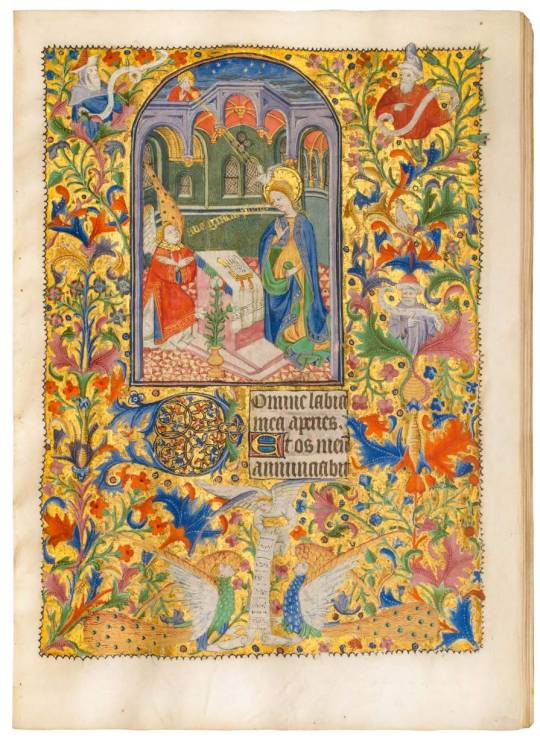
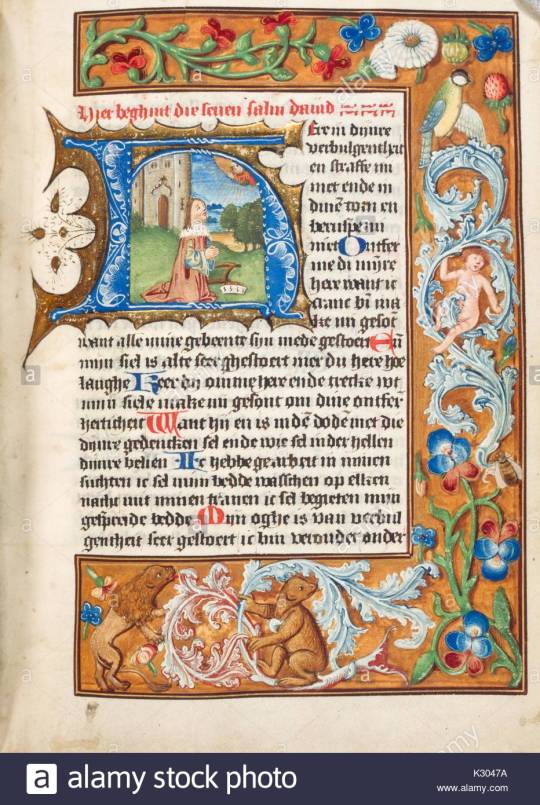

#collage inspiration#collage material#medieval manuscript#archaic illustration#medieval illustration#illuminated manuscript
4 notes
·
View notes
Text


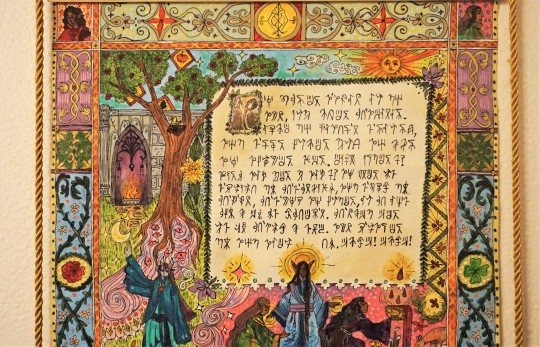
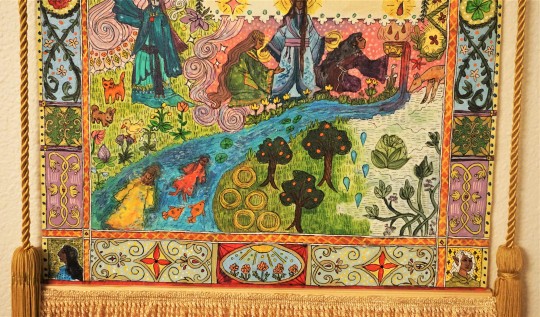

Finally finished my weird hanging painting thing (originally a secondhand partially-done 'paint by numbers' kit that I found at a thrift store and kept to repurpose lol)! Imagery somewhat based in my own worldbuilding projects, and text written in my constructed language for one of my fantasy species, but also vaguely inspired by old tapestries and illuminated manuscripts and etc. I've never been great at neat clean patterning or text, but it looks cool from afar, and I always enjoy making "props" or things that are somewhat like real objects that might could exist in my world. :0
(additional pictures/info under the readmore)
-
Here's what it was originally! I probably didn't have to actually have a river running down the middle because it further makes the composition of the whole thing weird (various connected yet separate locations and things happening, instead of one unified event being portrayed), but I wasn't sure if I'd be able to fully cover up the already existing paint that was there.. and I can also kind of justify it by going with a more "all the imagery is just symbolic so it doesn't have to make exact sense" approach lol.. How is one half of the grass green and the other is suddenly snowy? shhhh.. it's not literal.. shhh...

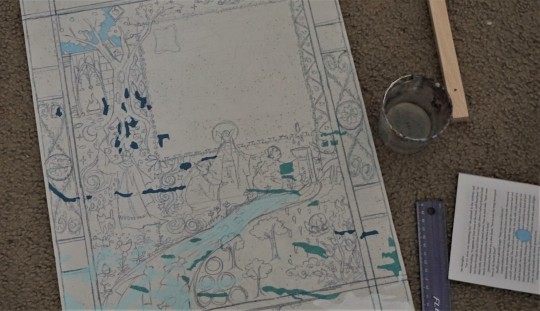
Made a vague sketch, then painted over it, and then added more distinct lines in black pen. Center image first and border second.
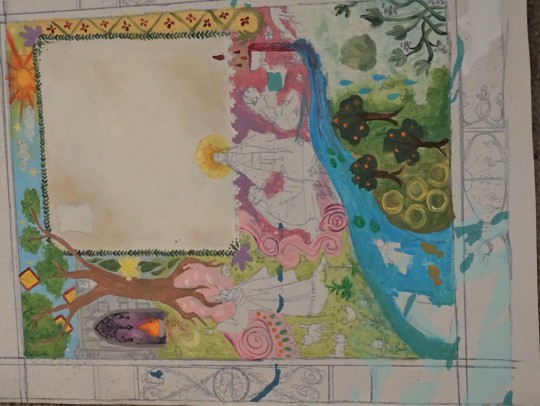
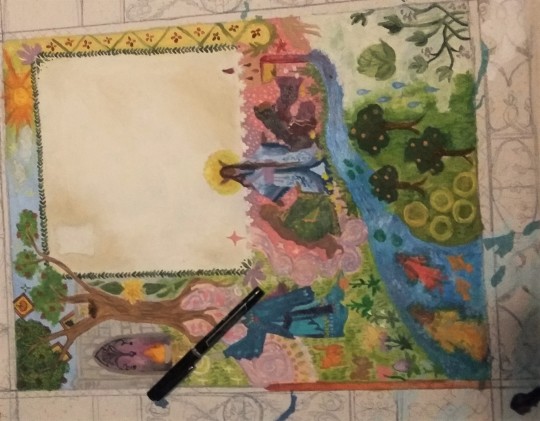
The very last thing was the text, which actually took forever to translate because my conlang is still only like.. partially done, and some of the grammar is not worked out exactly how I would like it to be, so a few sentences I had to think about for a long time before just going "eh, this is probably not how I would do it if I considered it more, but I'll go with it for now" lol . I also am not entirely satisfied with all of the characters for the writing system, but again, it's good enough for a quick project, it doesn't have to be 100% accurate and perfect because it's a fake language that nobody knows anyway lol.
I thought about breaking down the text and translation here like I have for some of the tidbits of Avirrekava (the language) in things I've posted in the past, but I think it would take too long and is not interesting to anyone but me ghghj, so for the sake of getting the post out quickly, I shall not spend an hour typing All That lol.
The general jist of the writing though is that it's just about the Avirre'thel being cast out from the other elves, after abandoning their magic for immortality as a means to truly attain perfection (an important concept in elven culture), the usual, blah blah blah, but how it's Actually A Good Thing, because the gods are wrong and immortality is Cool actually and they like the shitty frozen lands they were sent to, so it's fine that everyone else is being a Hater about it lol

Lastly, here's a few photos outside in the sun to TRY and show the gold detailing actually shimmering or showing up! It really doesn't come through in photos, but there's plenty of little golden spots to highlight light or Importance.
Mostly the fire, the pink sparkle that represents magic, the red drop that represents blood, the light behind Inaashi's hands and head (common symbol for the elven religion/one of their main gods, shout out to anyone who read the ancient elven religion post and recognized that lol), the sun, and the symbol for the Avirre'thel/country of Navyete at the very top. I did a few other gold bits, but they're not highlighted because they're Significant, more just that it looked more symmetrical to have some gold on the border too lol.
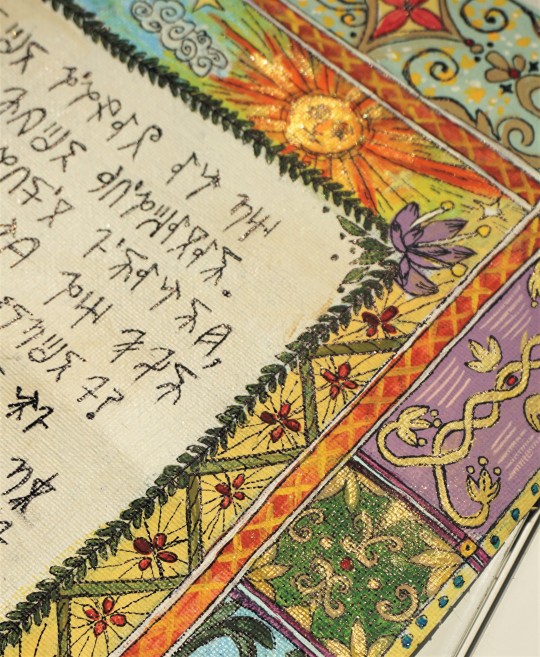
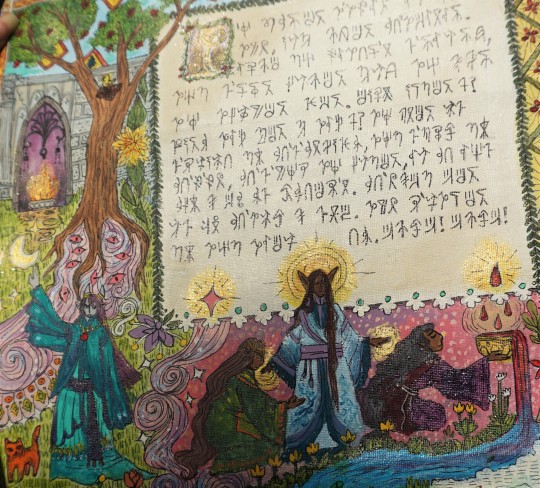
Other things of note: The animals are not actually significant to Avirre'thel culture really, I just wanted to put a cat and a bird because I like them lol. (I also wanted to have a few funny looking creatures, as I was slightly trying to go with the 'in some old medieval painting the anatomy and perspective is very weird' vibe, though I think some of the other parts of it look too Normal to pull it off entirely). Same with the four leaf clover, which means nothing in their culture - but these are the only areas where stuff was just added self-indulgently .
Bligabata (giant cabbage that grows along rivers in Navyete) making an appearance! The architecture of the building IS based on actual concepts for ancient elven/older Avirre'thel architecture and metalwork. The Avirre'thel who's turning away from Inaashi/elves/magic and collecting blood, is doing so in a Special Bowl, as is part of their culture (collecting it in the hands, or just in a normal vessel would be disrespectful, they have Specific Bowls which is the only thing blood can be kept in, etc.).
The figure that represents Jhevona (and thus, a closer connection to magic, celestial imagery, etc.) is in weird ugly teal, which is not necessarily a color or design associated with them, as I don't have much common culture (like clothing) worked out for Northern Jhevona (who the avirre'thel would have come into contact with) yet, BUT everyone else is in more Typical colors (a northern elf in green, Inaashi in lavender + white + blue, an Avirre'thel in darker purples and reds).
Some things, like the four figures in the corners, and the two people + fish in the stream, do not currently have a meaning, but in-world they would.. Like, I could make up lore for how they're culturally significant and it would be true because I am god of the world, but I don't have anything currently. But just know.. they DO mean something, I just haven't decided it yet, maybe kind of fill in as I go, come up with a meaning later lol. Probably along the lines of an old myth from the ancient elven religion, a story, etc.
-
I don't know, probably other stuff, but that's my Trying To Keep It Short rambling for now lol. I'm just glad I finally finished this! For how vaguely sloppy it is up close (everything being completely freehanded, only used rulers once when doing the initial sketch and lining where the border should be + my hands are shaky + the canvas is bumpy + my handwriting is scratchy and terrible + etc. etc.) it still took a REALLY long time, even when not trying to make it all perfect. Especially if including the text translation + writing, which took like 3+ hours itself.
Maybe all the asymmetry/lack of things being centered is NOT because I was too lazy to measure anything, but is actually because in-universe, it's a practice illustration made by some young apprentice who has to work on little canvases for years before he can be trusted will a full sized mural or tapestry. It's his first week on the job! of course he's uncoordinated! don't laugh at him!!! lol
#worldbuilding#elves#I AM WORKING ON A NEW PAVENTURE POST also !!!! I know I keep being like 'oh I'm going to get back to that! I'll stick to it this time!!'#and then another whole month goes by without me posting a new poll adventure - however - this time I DID fully intend to so#*do another one soon but my beloved beautiful perfect cat unfortunately passed away AND there was a heat#wave ANd I felt sick for a while for unrelated reasons so I just genuinely was not focused on posting online at all#I am trying to get back to it though along with other things hopefully so.#ANYWAY#avirre'thel#irithoas#maybe???? not super relevant to elves but I'll keep it intheir tag anyway also. Just since their lore is so closely tied with avirre'thel s#stuff and they're mentioned in the post. Or the gods are. Inaashi is.#OIGUGUGUGUHH I should have done a tapestry with the FCJhjkING triplets!!!!! Sehalanora Semoniyare and the other one whatever the hell#his name is. ... sehalanora my beloved .. (I'm referencing the ancient elven gods - for those who dont know)#It's funny that I rarely watch tv shows and when I do I rarely if EVER care about characters at all in any capacity#with maybe like a handful of even then extremely minor exceptions so I cannot relate to the concept of like 'having a blorbo' or whatever#but then for my extremely niche worldbuilding content#.. it's like OMG MY FAVORITE character!!! my favorite obscure god from a religion#that I entirely made up myself for a cultural group that I also made up that literally only I and maybe like two other#people who are able to sit through my novel long dry and wordy worldbuilding posts care about!! you all know them DUH!!#even WITHIN modern elven culture in the world at the moment in current day most people do not give a shit about them hghj#BUT .. I should have made a painting of the siblings actually!!! I stand by that!!#I mean I like Inaashi and Nisateyu and everything too. Actually all of them are fine except for Ea'ivuyera I guess. whoever the#like War and Order bootlicker god is basically. and the Evil dumbass one. but all the others are fine. I'm suprised I'm even able to rememb#that many ancient elven goofily long names ghgh.. But I could have maybe made it about the elven gods#The thing is just that.. i Don't have ancient elvish worked out as a language and I knew I wanted to put text on it#so it kind of HAD to be something written/drawn by the Avirre'thel#Knwoledge of the ancient elven gods is still a thing in their culture. But usually more as a joke or just a common fairytale knowledge#sort of thing. not really something to make a painting of. Inaashi is here less because of Inaashi The God being genuinely significant and#and more just she's there to Symbolize the elven religion as a whole. just like all the other figures are mere symbols of things. etc.
93 notes
·
View notes
Text
In Shakespeare’s Sisters, Ramie Targoff recovers to literary memory the lives and talents of four women who wrote in England during Shakespeare’s time, well before there was any notion of “a room of one’s own.” From Mary Sidney, sister of the well-known poet Sir Philip Sidney (she wrote most of the beautiful translations of the Psalms ascribed to him) to Anne Clifford, a diarist and memoirist who fought for decades against a patriarchy that tried to disinherit her from her family’s land, these women stun us by their bravery. In the passage below, Targoff discusses the important poetry of Aemilia Lanyer, born of an illiterate mother and an immigrant father; it appeared in print in 1611, making her the first woman in the 17th century to publish an original book of verse.
. . .
In the same year the King James Bible first appeared in print, establishing the most influential English translation of scripture ever produced, Aemilia dared to tell a different story. Over the course of 230 rhyming stanzas of eight lines each, her “Salve Deus Rex Judaeorum” lays out the story of Christ’s Passion from a distinctly female perspective. The formal challenge of writing the poem was itself daunting: it’s no easy feat to compose over 1,800 lines of ottava rima (iambic pentameter stanzas written in an abababcc rhyme scheme). But Aemilia’s greater audacity was in tackling the subject of Christ’s crucifixion. To justify this, she makes the same claim for divine inspiration that the great Protestant poet John Milton would make sixty or so years later in writing Paradise Lost. Describing her own “poor barren brain” as “far too weak” for the task, she asks God to “give me power and strength to write”:
Yet if he please to illuminate my spirit,
And give me wisdom from his holy hill,
That I may write part of his glorious merit,
If he vouchsafe to guide my hand and quill
Then will I tell of that sad blackfaced night,
Whose mourning Mantle covered Heavenly Light.
Given the fact that the poem proceeds to do exactly what she petitions for, Aemilia shows her reader that her prayer has been answered: she’s not so much writing as channeling the divine word.[...]
Aemilia’s narrative of Christ’s Passion begins on the “very night our Savior was betrayed.” As part of her overall strategy in “Salve Deus”of celebrating female virtue, the poem draws attention both to the wicked acts of men (Caiaphas, Judas) and to the compassionate acts of women (the daughters of Jerusalem, the Virgin Mary) in the days leading up to Christ’s arrest. None of this comes as a surprise. But when Aemilia arrives at the moment that Pontius Pilate considers Christ’s fate, she does something totally unanticipated. Relinquishing her own role as narrator, she hands the poem over to Pilate’s wife. Among the most minor figures in the New Testament, Pilate’s wife has a single line of verse in only one of the four gospels. In Matthew 27:19, a woman who is never named urges her husband, the Roman governor in Judaea, to disregard the will of the people calling for Christ to be crucified: “Have nothing to do with that just man,” she warns Pilate, “for I have suffered many things this day in a dream because of him.”
In early Christian commentaries and apocryphal writings, this woman was often called Procula Claudia, or simply Procula. In medieval England, Procula was paraded onstage in the mystery plays as an evil woman who almost prevented Christ’s saving humankind; in the York Cycle’s play named for her—The Dream of Pilate’s Wife—Percula, as she’s called there, receives her dream from the Devil himself. There’s no way to know if Aemilia knew this or other medieval dramas; it’s more likely she would have noticed the more positive treatment Pilate’s wife was given in the Geneva Bible, the popular translation done by English Protestants in the 1550s. Consistent with the Protestant belief that everyone should have access to the Bible directly, the translation was heavily glossed with marginal notes. Next to the verse from Matthew regarding Pilate’s wife was a single gloss suggesting that Pilate should have taken the “counsel of others to defend Christ’s innocence.” But whether the treatment of this woman was negative or positive, she had never been asked to perform the role Aemilia gave her in “Salve Deus,” where she delivers one of the strongest defenses for women’s rights that Christianity had ever seen.
In Pilate’s wife, Aemilia found her perfect heroine: a woman whose intervention at the crucial moment could have changed the course of history, if only her husband had listened. With the scriptural verse from Matthew before her, Aemilia made two crucial additions to the story. First, she transformed Pilate’s wife into a faithful believer who already regarded Christ as her Lord. “Hear the words of thy most worthy wife,” she begs her husband, “who sends to thee, to beg her Savior’s life.” Far from simply reporting that she’s had an ominous dream, as she does in Matthew, Pilate’s wife explicitly warns Pilate that he will be killing the son of God.
Second, Aemilia turned Pilate’s wife into a proto-feminist. After urging Pilate to let Christ go on religious grounds, she comes up with a new reason for why he should be pardoned: “Let not us women glory in men’s fall / Who had power given to over-rule us all.” If men are sinful enough to crucify their savior, then women should be liberated from men’s rule. “Your indiscretion sets us free,” she declares, “And makes our former fault much less appear.” In these four short lines, Aemilia’s character anticipates the killing of Christ as the basis for women’s freedom from patriarchy.
As if this weren’t radical enough, Pilate’s wife moves in “Salve Deus” from making her argument about the Crucifixion to recon- sidering the reason for Christ’s sacrifice in the first place. “Our mother Eve,” she exclaims,
. . . who tasted of the Tree
Giving to Adam what she held most dear,
Was simply good, and had no power to see,
The after-coming harm did not appear.
If Eve had no way to know the damage she might do, Adam was only too aware: it was he who received the command directly “from God’s mouth.” Eve was simply a victim of misinformation and “too much love,” whereas Adam, not betrayed by the “subtle Serpent’s falsehood,” knew exactly what he was doing.
Aemilia was certainly not the first person to defend Eve on grounds of her innocence or to propose that Adam be held responsible for the Fall. She was possibly the first to argue that the crime of killing Christ so overwhelmed any fault of Eve’s that women’s subordination should come to an immediate end. “If unjustly you condemn [Christ] to die,” Pilate’s wife concludes,
. . . Then let us have our Liberty again,
And challenge [attribute] to your selves no Sovereignty;
You came not in the world without our pain,
Make that a bar against your cruelty;
Your fault being greater, why should you disdain
Our being your equals, free from tyranny?
If one weak woman simply did offend,
This sin of yours, hath no excuse, nor end.
Hundreds of years before the women’s liberation movement, Aemilia used the figure of Pilate’s wife to argue that the sexes should be equal. In doing so, she also rescued a voice from history, giving full personhood and agency to a woman whom the Bible didn’t regard as worthy of a name.
More on this book and author:
Learn more about Shakespeare’s Sisters by Ramie Targoff.
Browse other books by Ramie Targoff and follow her on Instagram @ramietargoff.
Hear Ramie Targoff read at the Boston Athenaeum in Boston on May 15, 6:00 - 7:00 PM. Click here to join virtually.
Visit our Tumblr to peruse poems, audio recordings, and broadsides in the Knopf poem-a-day series.
To share the poem-a-day experience with friends, pass along this link.
#poetry#knopf#poem-a-day#knopf poetry#national poetry month#poetry month#knopfpoetry#poem#ramie targoff#targoffaudio#shakespeare's sisters#shakespeare
11 notes
·
View notes
Text

The exact origin of the Kol Nidre melody is a bit of a mystery…
It's been claimed that the melody's roots can be found in German medieval folk music. Others have rejected this idea, arguing that it is clearly of Jewish origin.
There is, in fact, not just one Kol Nidre melody, but a collection of musical themes which came together and settled in a permanent order at some point during the 15th or 16th centuries.
The combination of the religious setting, the emotional backdrop, and the powerful melody creates a unique psychological atmosphere among those gathered to hear the prayer on Yom Kippur.
Much of this has to do with the ability of music to reach into the soul, even if the listener cannot understand the words. A few notes are often enough to trigger intense feelings and bring back old memories.
Over the centuries, the Kol Nidre melody has inspired countless musicians and artists, from classical composers to filmmakers to psychedelic rock bands.
See the first comment below to read on…
#YomKippur
The image below, an initial-word panel for the Kol Nidre prayer featuring decorative dragons and mythical beasts, appears in a Hebrew illuminated manuscript made in Germany in the early 14th century. It can be found at Oxford's Bodleian Library (MS. Mich. 619, fol. 100), zoom in here
National Library of Israel
37 notes
·
View notes
Note
Since you are the world’s leading expert on Disney villains, which villains have your favourite aesthetics/vibe? For me, Horned King is not even in my top 20, but his general aesthetic and the design of him, his castle and his army…I love it.
Oooh, I LOVE this question!
So, in general, I'm a very aesthetic and vibe oriented person, and in my case, for the most part, my favorite aesthetics and vibes correspond to my favorite villains. However, even though Maleficent is my top favorite villain, the one who has my favorite aesthetic and vibe is Queen Grimhilde.

I was talking with a friend of mine about which Disney screencaps most incarnate our vibes, and Grimhilde's very first shot was my pick for myself:

The color scheme with the purples, blacks, and blues, the dark medieval castle setting with its mixture of grandeur and mysteriousness, the star and moon curtains that represent the cosmos, the zodiac signs adorning the mirror, the magical witchcraft that is about to ensue with the queen and the mirror, the eerie looking dim torches on either side of her - it all just is so captivating for me right from the get go.
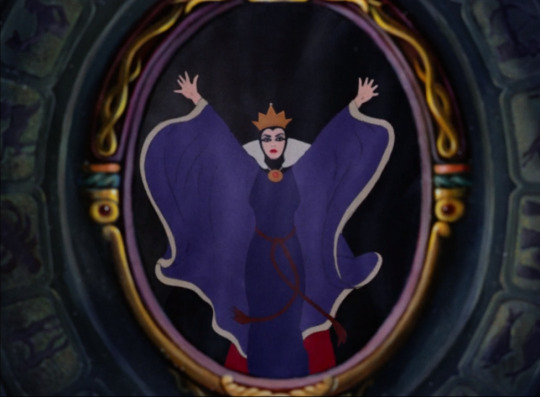
I love her outfit and how flowing it is and the way it catches the wind and flutters about. The purples, the reds, and the blacks are just the prime villain color scheme, and I'm here for it! And the spell to summon the mirror has such amazing writing in general that conveys the mythic feel.

I love fire and fiery aesthetics in general (Maleficent, Hades, and Jafar have entered the chat), so having her bring that in during the summoning of the mirror is great. This shot is just so dynamic and visually appealing to me. Speaking of...
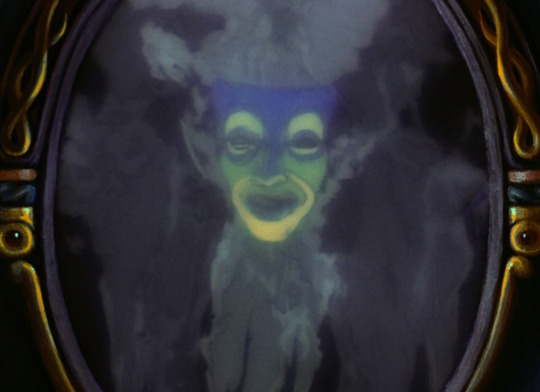
The Spirit of the Magic Mirror in general is such a cool aesthetic to me. I love the way he's only a floating theater mask illuminated in greens and blues and kind of distorted by the billowing smoke behind the looking glass that obscures the view of a world of total darkness. It has such a classic mythic feel to it that he captures my imagination every time.
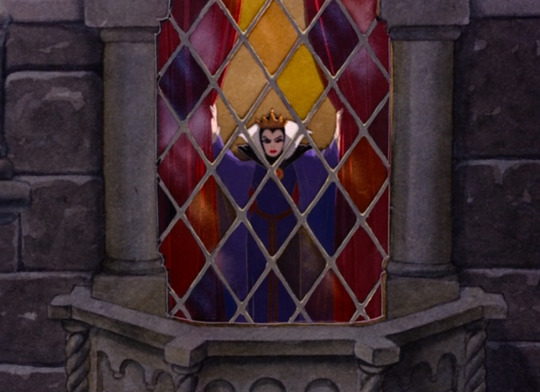
Me when the neighbor kids are making a loud ruckus outside XD
This shot is just so beautiful though! The carved balcony, the diamond design on the window pane, the vibrant blood red curtains, and the queen herself framing herself perfectly as she watches the hated youths below cavorting in her courtyard.

OPPULENCE! YOU. OWN. EVERYTHING! I love her throne room. The ornate peacock shaped throne is of course stunning and so thematically appropriate, but I also love the details of the coat of arms and the woodwork on the sides. It feels RICH and ROYAL. And I love the way that she drapes her flowing clothing over the throne when she sits. The scepter on the pillow next to her is a great background detail, and once again those deep beautiful red curtains are immaculate.

Shout out to Humbert the Huntsman. I like his design a lot - we don't really see middle aged men in animation who are designed to have realistic faces and body proportions any more.
Also take note of the castle detailing of the background and the shield with the crossed hatchets off to the side. All of that is part of Grimhilde too.
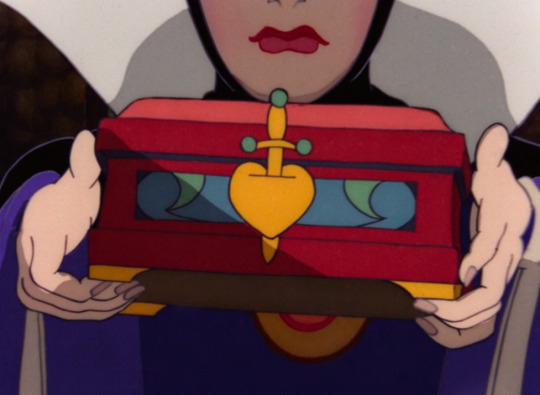
I love the box she has for Snow White's heart. The detail of the latch being a dagger piercing a heart is inspired, and the blood red color of it is so visually evocative. Also the pattern on the side is very visually interesting even if I'm not sure what it's supposed to represent.
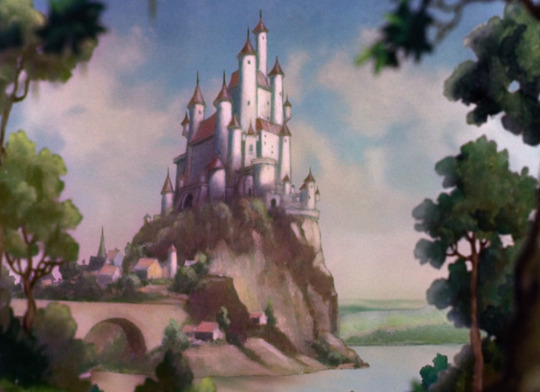
Her castle's exterior is also worth noting. During the daylight, it's very pretty and regal, but it's more in Snow White's color palette. But at night...

Once the sun sets and Snow White has left its halls, it becomes every bit a dark and imposing fortress befitting Grimhilde's dark majesty.

I just love those star and moon curtains and her flowing cape so much XD But also notice those vibrant green eyes of hers! As a fellow member of the green eyes segment of the population, I feel seen XD

Wearing a blanket down the stairs vibes XD Obviously I love the whole flow of her clothing in this shot, but I also love how up until now, everything around Grimhilde has been very regal and imposing, but we see her leaving the majesty of the mirror chamber and descending into the depths of darkness and decay marked by the presence of rats and other vermin.
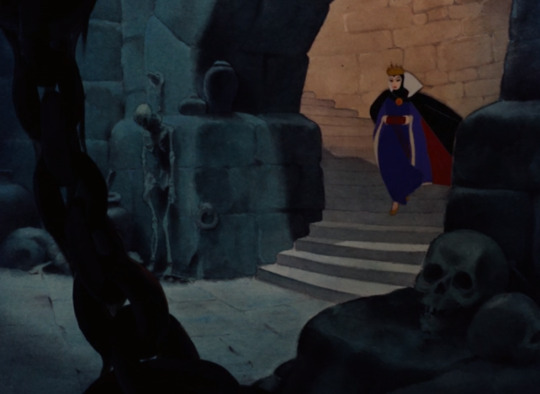
Any warmth is drained from the shot. Also, skeletons and skulls and chains. Love them!

And it just keeps going with coffins and cobwebs that obscure our view. It's spooky Halloween-core in its highest form now!
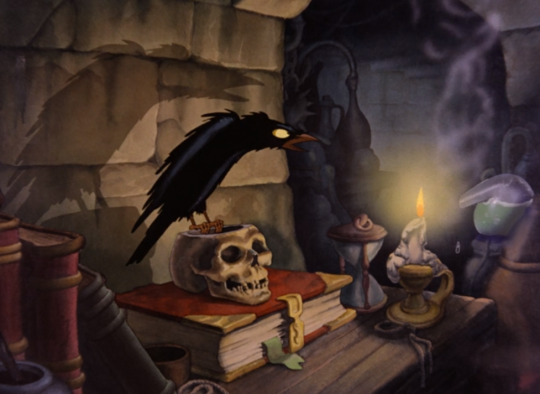
The raven is a great counterpoint to Grimhilde in a dark inverse of Snow White being kind and a friend to the birds whilst Grimhilde is scaring the living beejezums outta this poor thing. The heavy tomes, the skull on display, the hourglass, the melted candle, the bubbling beaker - it's all just so many great details that scream WITCH!
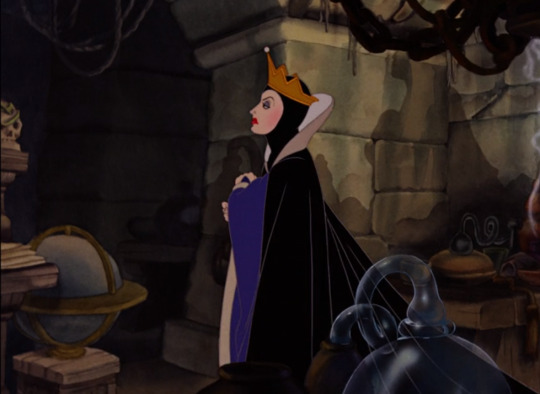
I love the detail of the globe in this shot in particular. Like it's down here with her macabre magical artifacts rather than anywhere more royal or diplomatic. You really get the feeling that she wants her dark magic to spread across the entire world. Also it hints at her being well traveled and worldly, which with what we know about her backstory is very true.

I don't want to hear anyone say that Grimhilde wasn't FULL of dark magic. We only saw her cast TWO spells out of all of these dark spellbooks. She has LOADS of power that we haven't fully seen, and those implications make her chilling. I'm also very intrigued by the nature of each of these. Astrology is obvious and harkens back to the zodiac signs adorning her mirror, which I love. But she's got the Black Arts, Alchemy, Witchcraft, Black Magic (which has the word DEATH at the bottom), Disguises, Sorcery, and Poisons. I wonder what the difference is between Black Arts and Black Magic since they're terms usually used interchangeably. Black Magic at least seems to be focused mostly on death based magic, so perhaps Black Arts are dark spells that extend beyond necromancy and killing curses.
Also I love hands and how expressive a person's hands can be, and Grimhilde's perfect manicure as she peruses the shelf is so visually appealing to me.

Look at her little skeleton man scale on the left! That's SO classic goth, and I LIVE for it XD He even has a little crown XD

This just has such cool and creepy vibes like finding an old worn book that has research material you need and having this vibe of unearthing long lost knowledge. Also look at the other page. It seems there may be some use for the heart of that pig after all ;)
But the ingredients are so classically witchy and spooky, and I enjoy the way they take the time to show Grimhilde adding each one and focusing on its unique visual properties.
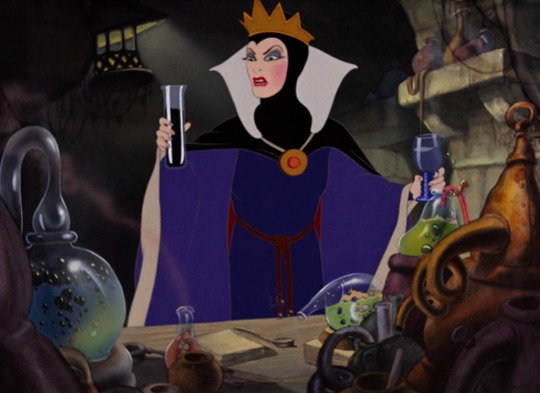
Everything bubbling around her, and that unique light fixture right behind her always make this shot so dynamic and visually interesting as we begin the spell...

I love how the Black of Night slowly snakes its way down and engulfs the potion
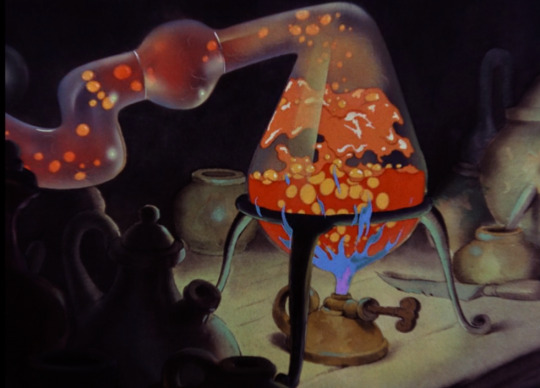
An Old Hag's Cackle. I love how it's a sound that has been distilled in liquid form and when heated it bubbles up and unleashes the cackle.

A Scream of Fright! I love how the steam becomes a shrieking phantom as it rises.

I think this is genuinely one of the BEST and most dynamic shots in all of Disney history. The way Grimhilde's face is reflected in the potion as it bubbles and smokes, the green of it, the placement of the hand, it's all just MARVELOUS and I love how it's also our last real look at her before the transformation. Almost like she's getting consumed by the potion right before our eyes.

Then of course her Old Hag form is one of my favorite character designs in Disney. Look at how striking she is! How viscerally frightening! How utterly mad she appears to be! It's PERFECT!

Notice "Formulae Mortis" next to the raven hiding in the skull - more magic!

And the recipe for the Poison Apple with the beautiful and dark illustrations in the margins!

I love the aesthetic of cauldrons. I love the bubbling witches brew with the blue and the greens as it billows steam that clouds the entire room. I love the hag peaking through the curtain of fog as she dips the apple into the brew, eagerly anticipating her ultimate victory by this one dark act.
And of course...

THE APPLE! One of the most iconic pieces of imagery in film history. The dripping poison making the death's head as the magic seeps into the darkened fruit before turning it a luscious and tempting red to hide its malevolent purpose.
Her aesthetic and surrounding imagery is just so evocative and classically gothic and medieval and witchy that I just go gaga over it every time! She is that exact intersection between Halloween, fantasy, history, the esoteric, the mystical, and the deadly that captivates my personal tastes so much, and I just always find her and her vibes to be PEAK Disney Villain! And, when you think about it, every other villain in the lineup owes their entire existence to her, and their vibes and aesthetics are in turn derivative of Grimhilde and the gold standard that she set.
I could go on and on even further about Grimhilde and her aesthetic and her vibes, but I am unfortunately at the tumblr image limit and so I can't embed anything more XD But, yeah, you probably weren't looking for a deep dive answer, but you hit on two of my hyper fixations and so you get the info dump with visual aids! Sorry, not sorry XDD
10 notes
·
View notes
Note
Hey so for your hs au, we're the kids always big dragon things or did they become dragon things at some point via wacky sburb shit? Love the designs they are so cool
Thank you so much!!
The au was inspired by some posts I saw (can’t find them now 😔) that were essentially just talking about how cruel SBURB is, and it got me thinkin a bit.
At this point I’d already had the idea “hey what if godtier let them turn into big monsters” because, and you may notice a theme here, I really like big monsters. There was no lore at all at that point. They literally just. Were big monsters. For fun!
But I got thinking about it more, and kind of came to this conclusion:
Godtiering steals your life, your very humanity from you. It makes you a god, by definition. What if that was very literal?
So the au is everyone starts out like normal, but once you godtier things start to get weird. It starts small, a single pair of wings (which, ironically they don’t actually use to fly. They could, but they still have their floaty godtier powers (and honestly there’s a whole lot of lore around THAT too)). The more you use your godtiering powers and the more time you spend as a god, the less you really… fit inside a human/troll/etc. shape, anymore, and the more your body starts to morph into something larger and grander. Something more befitting of those who have mastered the game.
And that’s basically it, that’s the only way this au diverges from canon. It’s essentially a re-skin of an au lmao
I will say the gods can return to a human shape, but only visually and it’s difficult. They sort of come to embody their aspects - literally - so if they can figure out a way to condense or conceal their aspect, they can in turn condense themselves to be something smaller. Like I said, it’s tricky though. It’s probably something they would’ve only figured out post-canon. That, and it’s something they have to consciously maintain. If they don’t, the rest of them starts to “bleed through” back into visible reality in weird ways. Since it’s all tailored to their aspect it looks different for each of them. I want to draw Dave bleeding through sometime because I have a really cool idea for what it would look like for him.
One last thing, more of a design note than anything. I actually… don’t really like their designs yet. Well, I guess it’s more that they’re not really what I want yet? I do like some of them (especially Dave’s, Dave might not need any revisions actually). While designing them I really want to model them after two concepts:
1. Illuminated manuscripts and heraldic beasts, because the classes are based off of medieval fantasy and I think it’d be sick to reference that.
2. Eldritch/cosmic horror, because that more than anything emphasizes that they don’t really belong in any one universe anymore, and also emphasizes their loss of mortality and thus, in a way, life.
I feel like most of them lean too far towards either one, and aren’t balanced between them like I want. Hence why I’m unsatisfied with them atm! I am very glad you like them though :)
10 notes
·
View notes